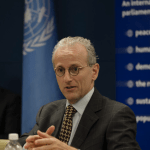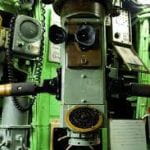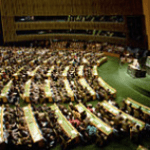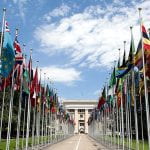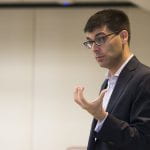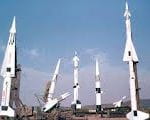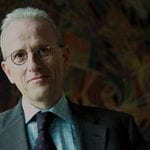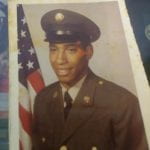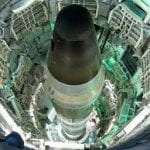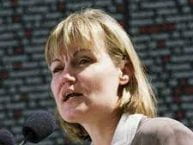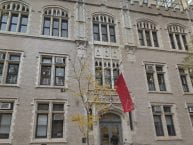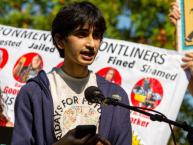On January 27, 2023, the nuclear weapons group (Me, Tyler, Erick, and Ajax) left school to head over to midtown and take a tour of the United Nations. What was expected to be a virtual interview with head of the Department of Peace Operations, Daniel Prins, auspiciously wounded up being a full on tour of the United Nation’s buildings and Department of Peace sector along with an informal interview at the fainting minutes of the previous but valuable time we spent with Daniel.
At first, we had to go through the necessary security precautions, and followed through with a recollection of how the U.N. situated it’s base at the most Eastern side of Midtown, Manhattan. What was once a slaughterhouse, evinced by the miniscule windows in an old building, the owners of the location (The Rockefeller Family) decided to donate the entire land to the United Nations after they were formally created in 1948 for no charge whatsoever.
The territory is not under neither New York or American control whatsoever. The jurisdiction of the country and city instantly vanish the moment your foot steps into the premise. It is the World’s property, and there will be United Nations guards instead of New York Guards, and laws that could suppress a person are uplifted. Only if the rare instance of an emergency are the New York Fire Department or Aide Services allowed to intervene.
After a short period in which we got a gist of the types of gifts from foreign countries were sent to the U.N. regardless of their worth or look, we went inside the iconic building. After our chaperon (Momii) had her id checked, Daniel headed us in the direction of the United Nations Meeting Room. Unfortunately paused in speech due to what was soon to be a direct meeting due to the date being International Holocaust Remembrance Day, we had to be ushered off the chairs and into a different room, not before we took some pictures though.
For the next part of the tour, we stumbled upon a display of landmines. There were different variations of land mines. Some would not explode if a human would step on it, but would detonate if a 6,000 pound vehicle drove over it. There was a collectives treaty to forbid land mines in countries, and despite a majority of the 193 countries in the U.N. that agreed to prohibit the buying and usage of land mines, some countries opted to not abide by those rules. Russia for example, decided against the removal of land mines, so they are openly using land mines in the war against Ukraine.
To the next section of chemical weapons, these extremely deadly and effective weapons were used in World War 1. Instead of filling up artillery guns or cannon launchers with ammo, they were filled up with the deadly toxins. These were highly ineffective on most occasions, as if the wind would change it’s trajectory, the weapons would push right back on the people who launched it. The targets were also not perfect and sometimes it would kill innocent civilians who were miles separated from the front lines. This danger to humanity lead to the majority of countries, including Russia, prohibit chemical weapons usage in war.
Onto the section of nuclear weapons, and the reason we went to the U.N., still in the same room, we shifted to the focus of nuclear usage and disarmament. Proliferation means spread, and non-proliferation means controlling the spread of something. That was the purpose Daniel Prins was working for the U.N. for many years. After the United States launched two devastating nuclear weapons on two of Japan’s major cities (Hiroshima and Nagasaki), and after a continuous cold war that spanned the span of almost half a century and threatened the very existence of humanity, the world decided that the best way to save humanity from this threat was instead of increasing nuclear weapons arsenal as to prevent other sides from firing in fear of retaliation, it was decided that the best option was to get rid of nuclear weapons altogether.
This obviously was very hard as many countries were defined on their nuclear might, and might not have anything else to show in terms of importance to the global balance of power besides that. For example right now, North Korea and Russia as quoted from former missileer Lawrence Bullock, “want to become the U.S.’s enemies by increasing nuclear weapons, because if the U.S. are enemies with them, they will be able to somewhat dictate global decisions”.
The Five Major nuclear powers, who are permanent members in the Security Counsel, France (300 estimated nuclear weapons), Britain (350), China (600), American (5,500), Then Soviet-Union present day Russia (6,500) devised a plan that would make these five powers second guess on a nuclear assault on these countries territory. If one of the countries were to send a nuclear weapon to the other, the country that received the nuclear attack would respond in kind by sending their own nukes. Though it would guarantee continual mass destruction and a possible end to humanity, the plan was devised so that the very thought of responding in kind would never be pondered because none of the countries would think of sending a nuclear weapon on another country.
The Achilles heal in this plan though is that countries who have just developed nuclear weapons are not in the deal. North Korea, one of these nuclear powers was once in the deal, but pulled out because they didn’t want to be puppeted around due to their dictator (Kim Jong-Un)’s utter hunger for power and fame. Along with that country with a nuclear arsenal still on the loose, border rivals India, and Pakistan, along with the 74 year old Israel all boast a nuclear arsenal and are not under restrictions from the deal as it remains as just those five powers.
On the other hand, I wondered what in the world could possibly excuse the launch of a nuclear weapon? What could a country possibly be able to use as an alibi for the direct usage on humanity with a weapon of such mass destruction? Daniel said that if a country were faced with an existential threat, they would perhaps only be excused to use a nuclear weapon if there was a direct threat to the complete dissolvement of the country and its foundation. In the Russo-Ukraine War, despite heavy sanctions being imposed on Russia, and multiple world powers sending in military might to aide Ukraine, Russia still hasn’t stated that there was a direct threat large enough to crumble their government which could excuse a nuclear launch. Saying something that radical when they started the war, and when you would think it would make them sound like they are losing the war which is the opposite of what Putin wants them to think would seem non sensical. So the likelihood of a nuclear assault the help change the tides of the war in Russia’s favor seem unlikely.
How a country would be able to abide by these treaties depends on their power, and genuine influence over the country. To assert laws, you need enough man power and technology. In some countries, the government doesn’t even control the country due to their lack of power. Military strength is critical in deciding a government’s hold on a country.
All of this might seem a bit hard to digest, but if you take time in reading all these short mini paragraphs, you realize that there is a certain pattern interconnecting every claim. For every threat to human life, or weapon that can be used inappropriately and in mass amounts is quick to be thrust down and be only trusted in the hands of the highest leaders in the highest countries, regardless of whether they’re idiots or not. To prevent from the destruction of the whole world if a major nuclear power has an absolute baboon for a president, The United Nations has and is still keeping the world in check. As quoted from the second U.N. Secretary General, Dag Hammarskjold, “The United Nations was not created in order to bring us to heaven, but in order to save us from hell”.
Read more
